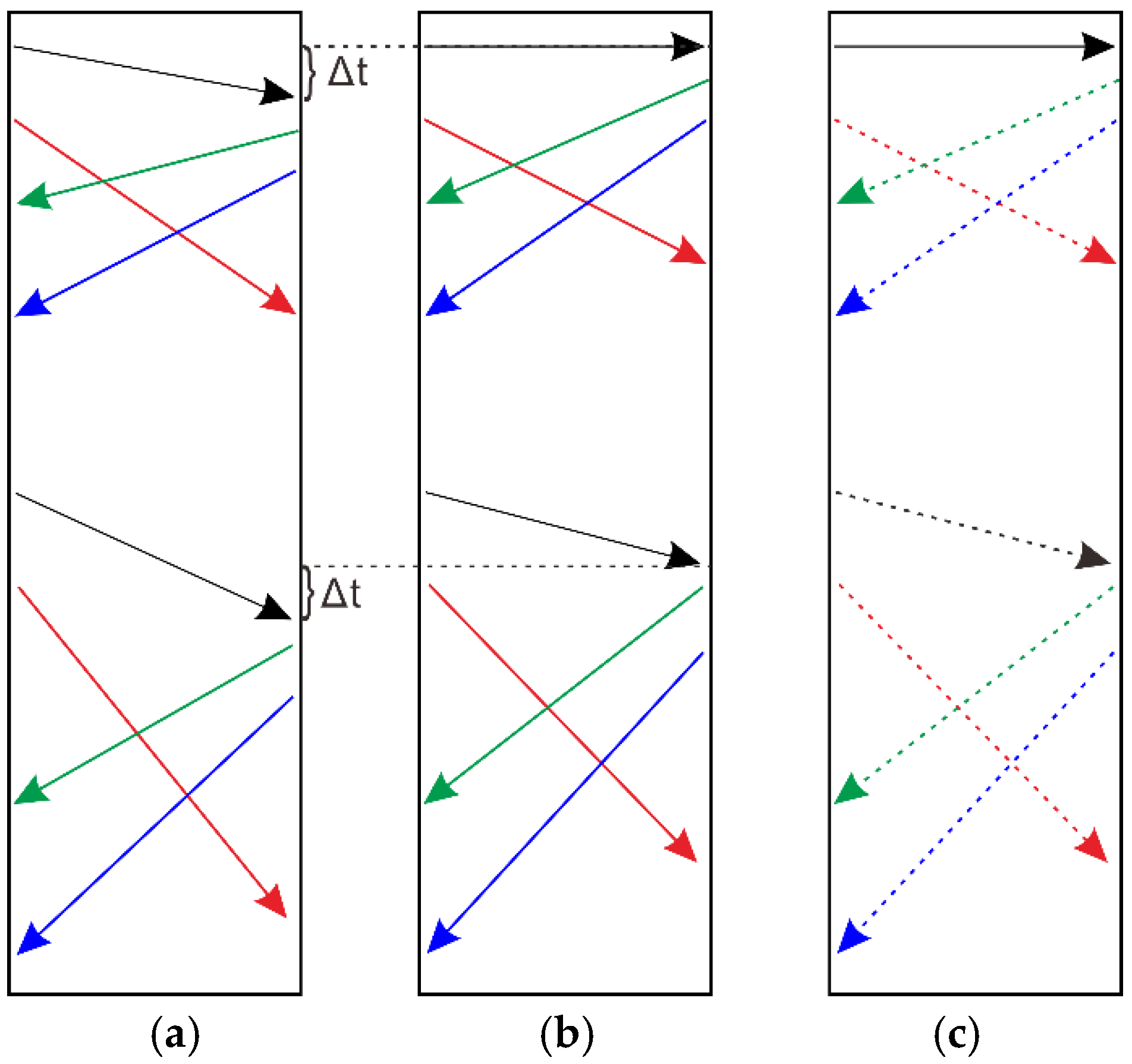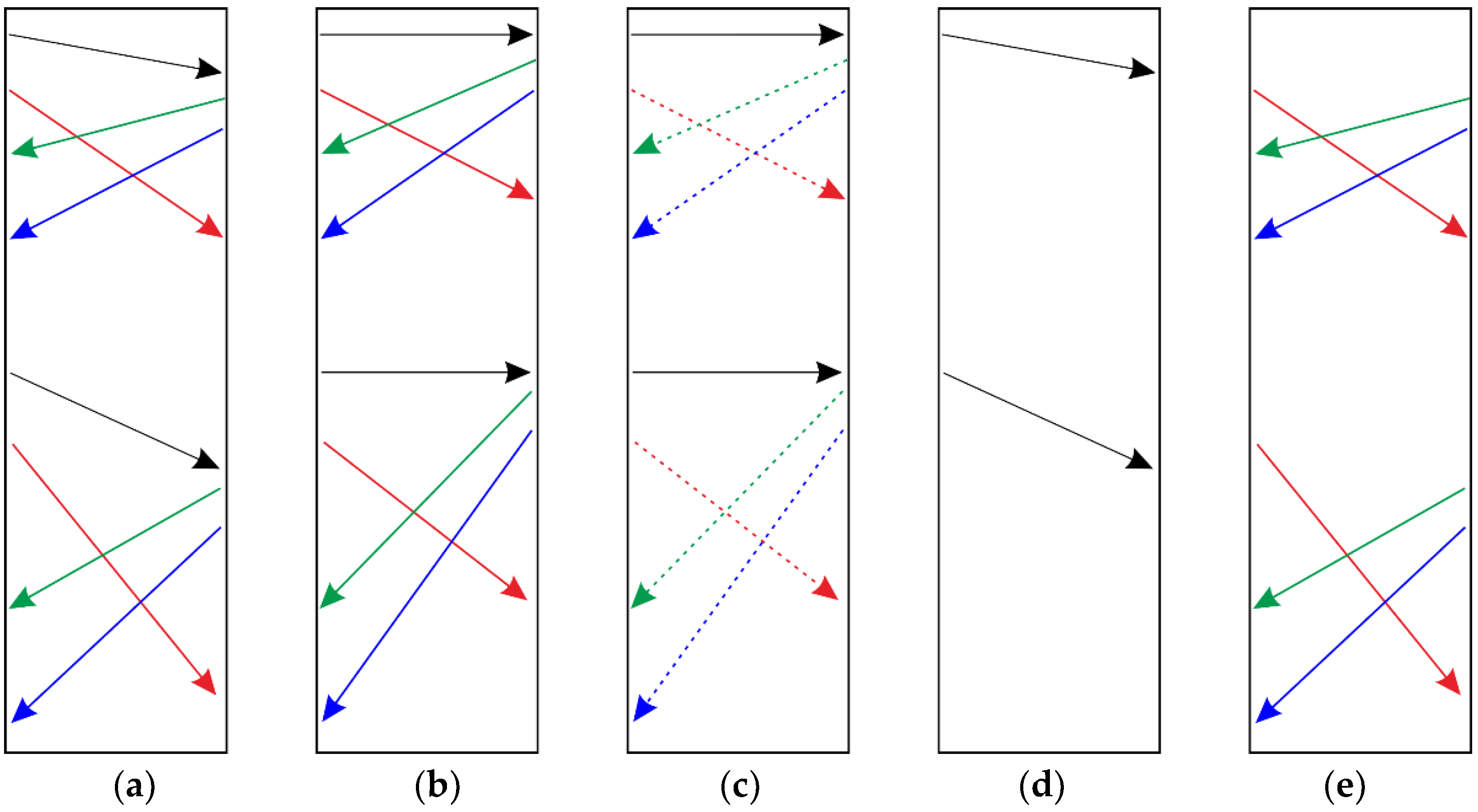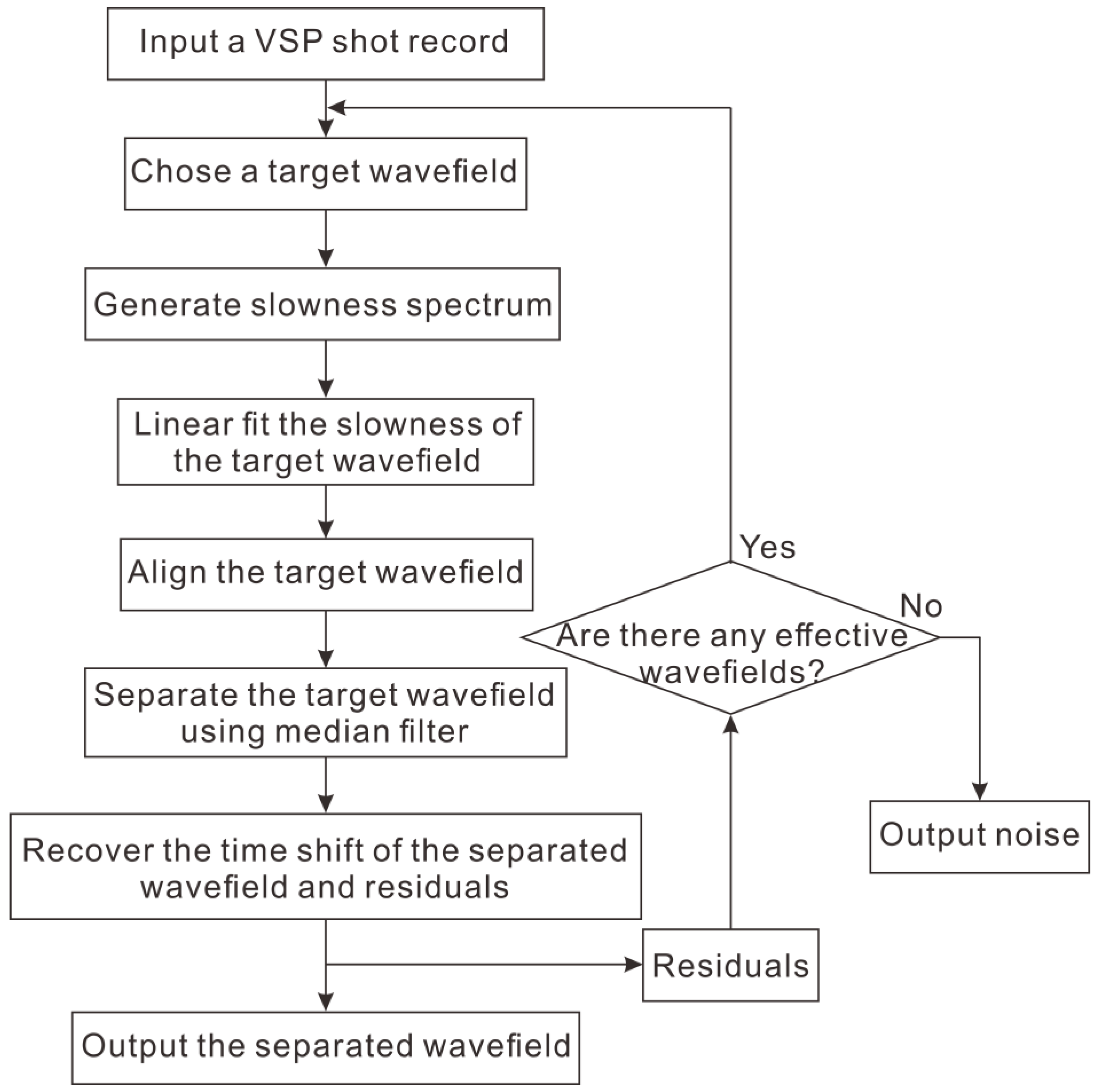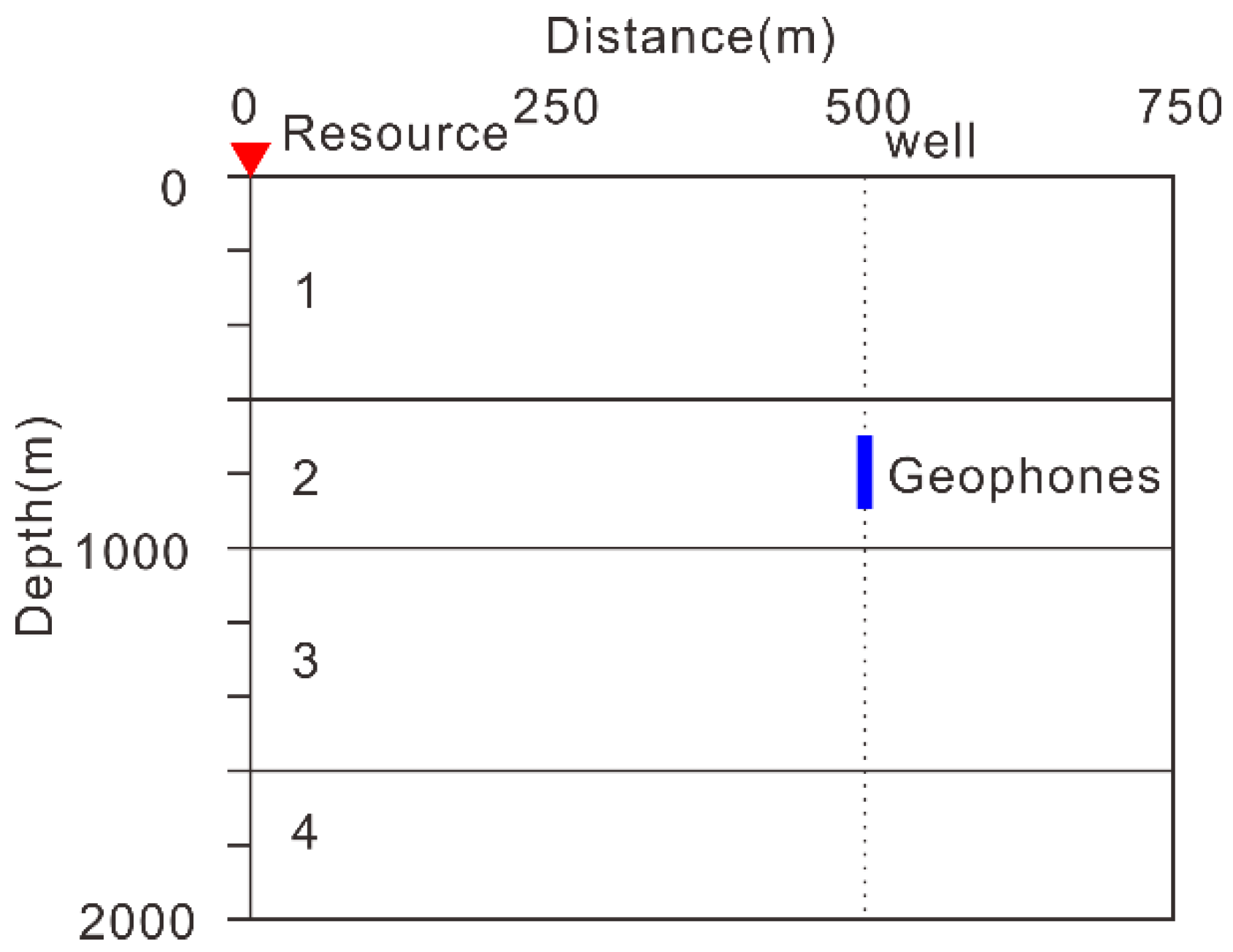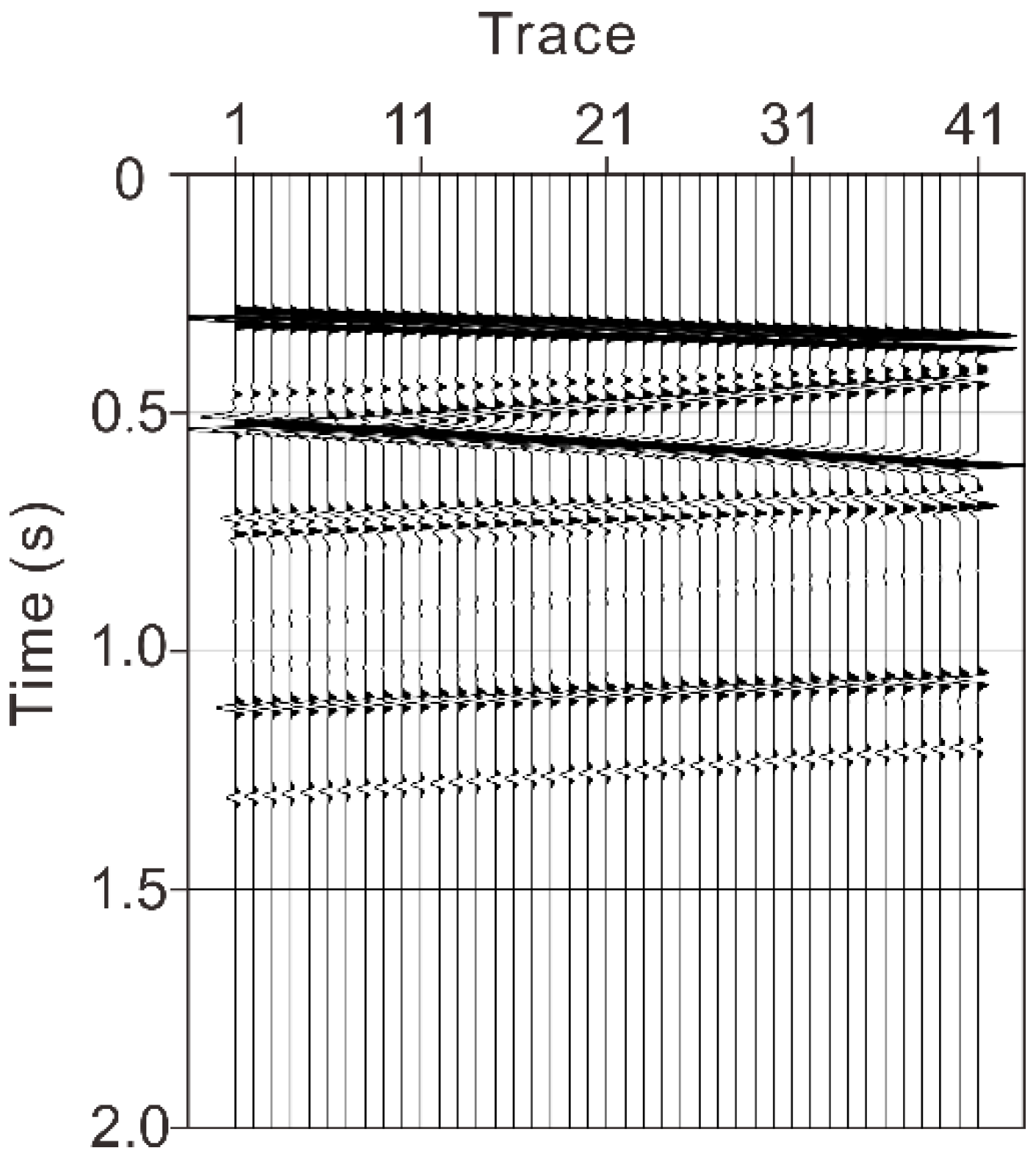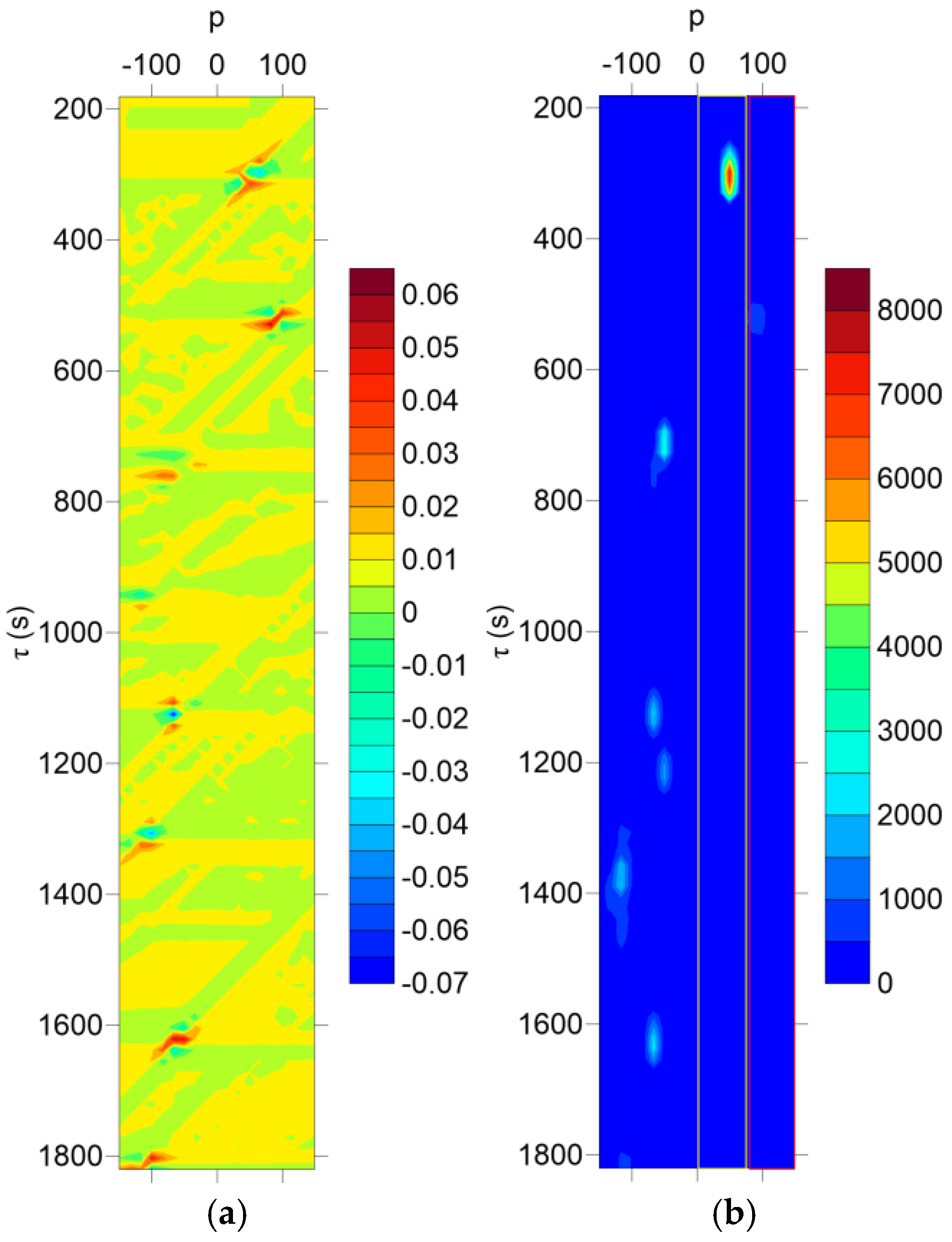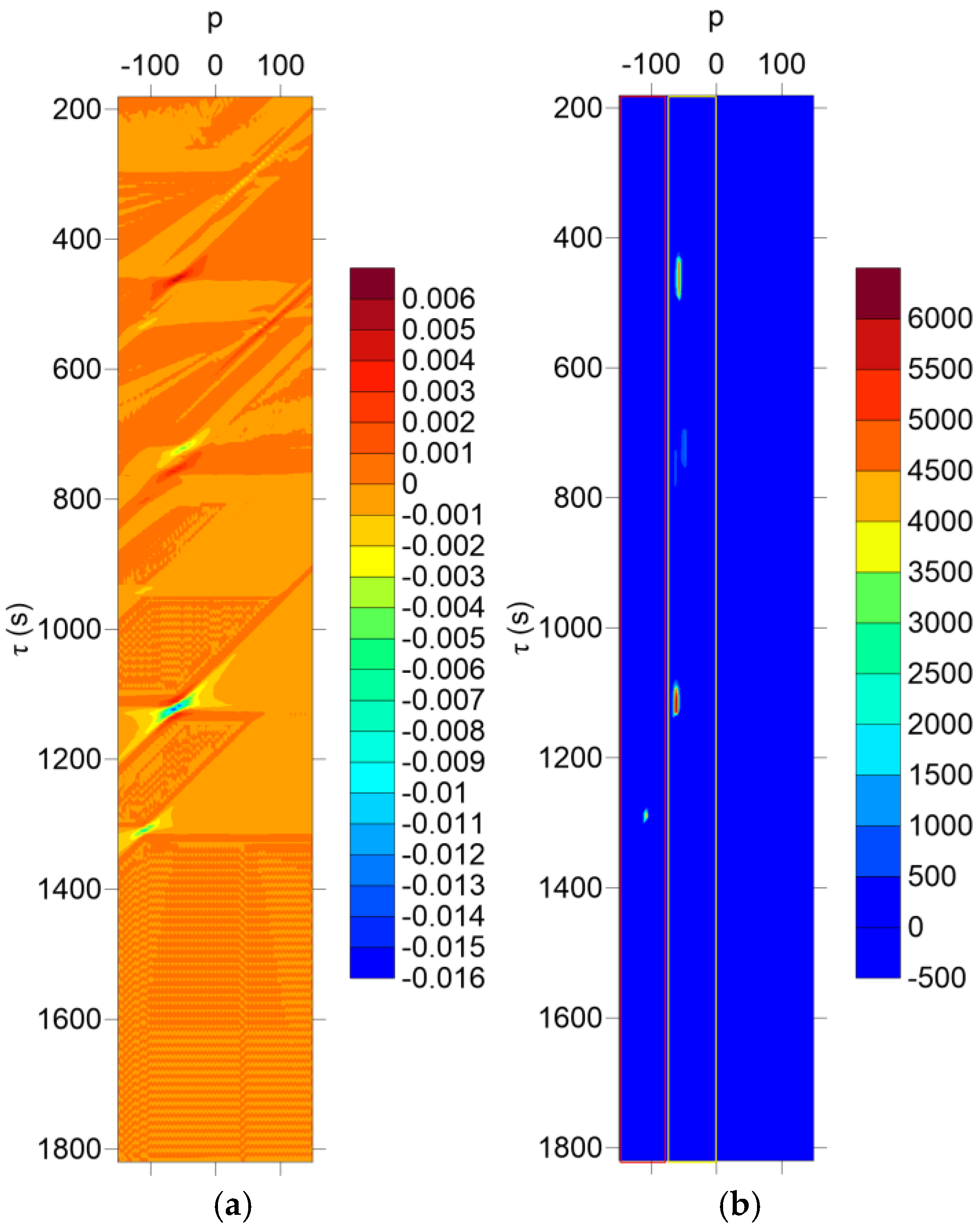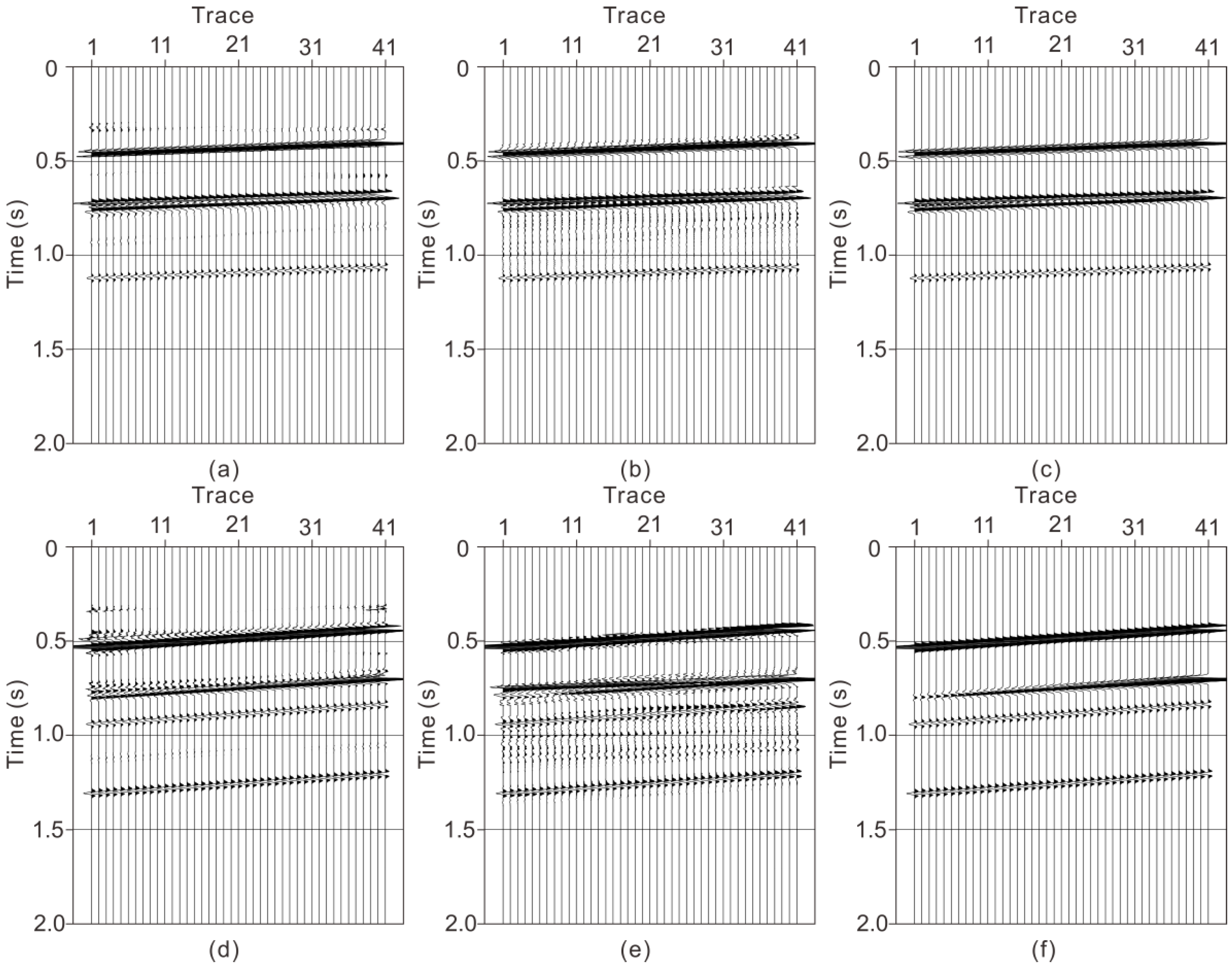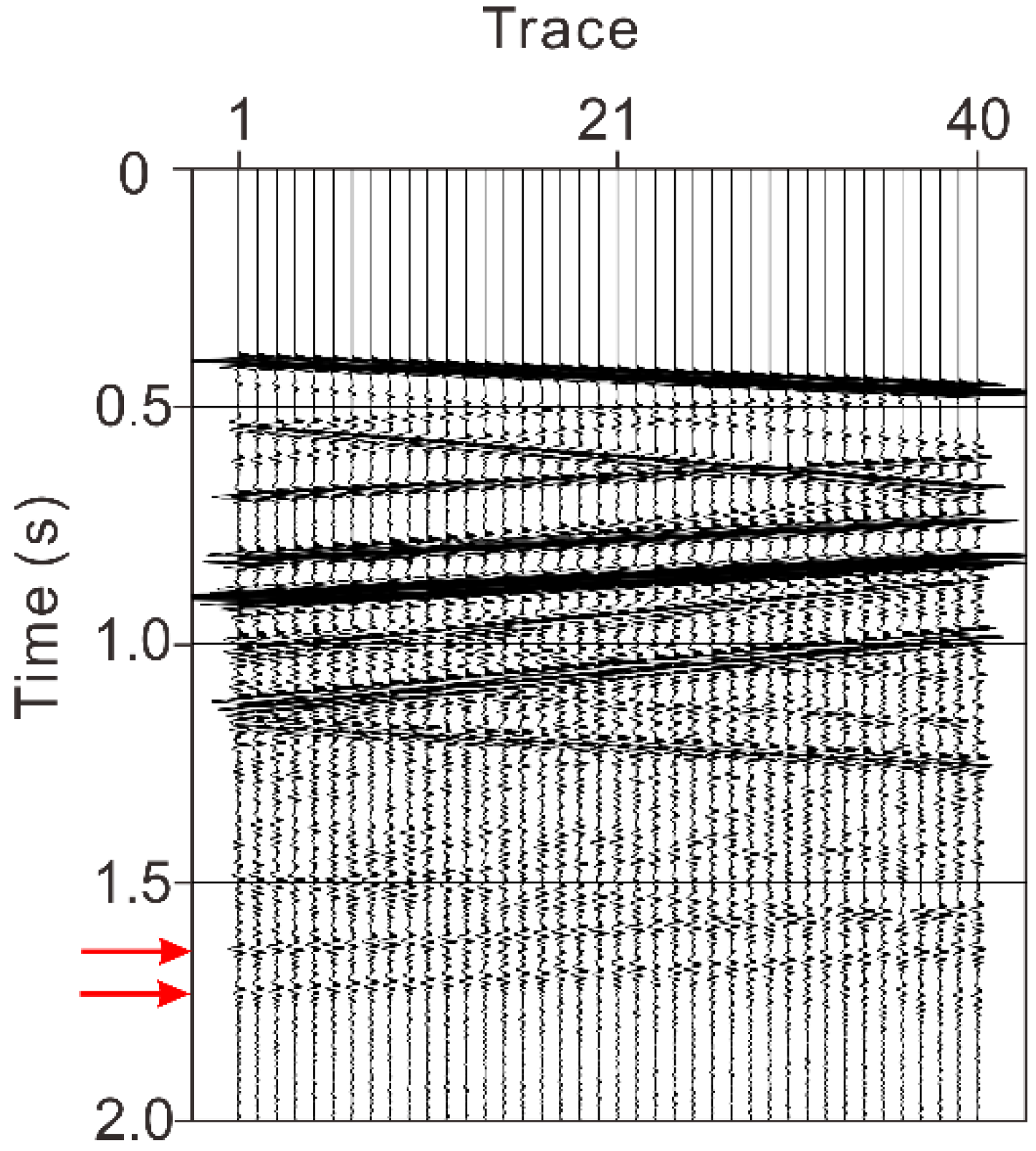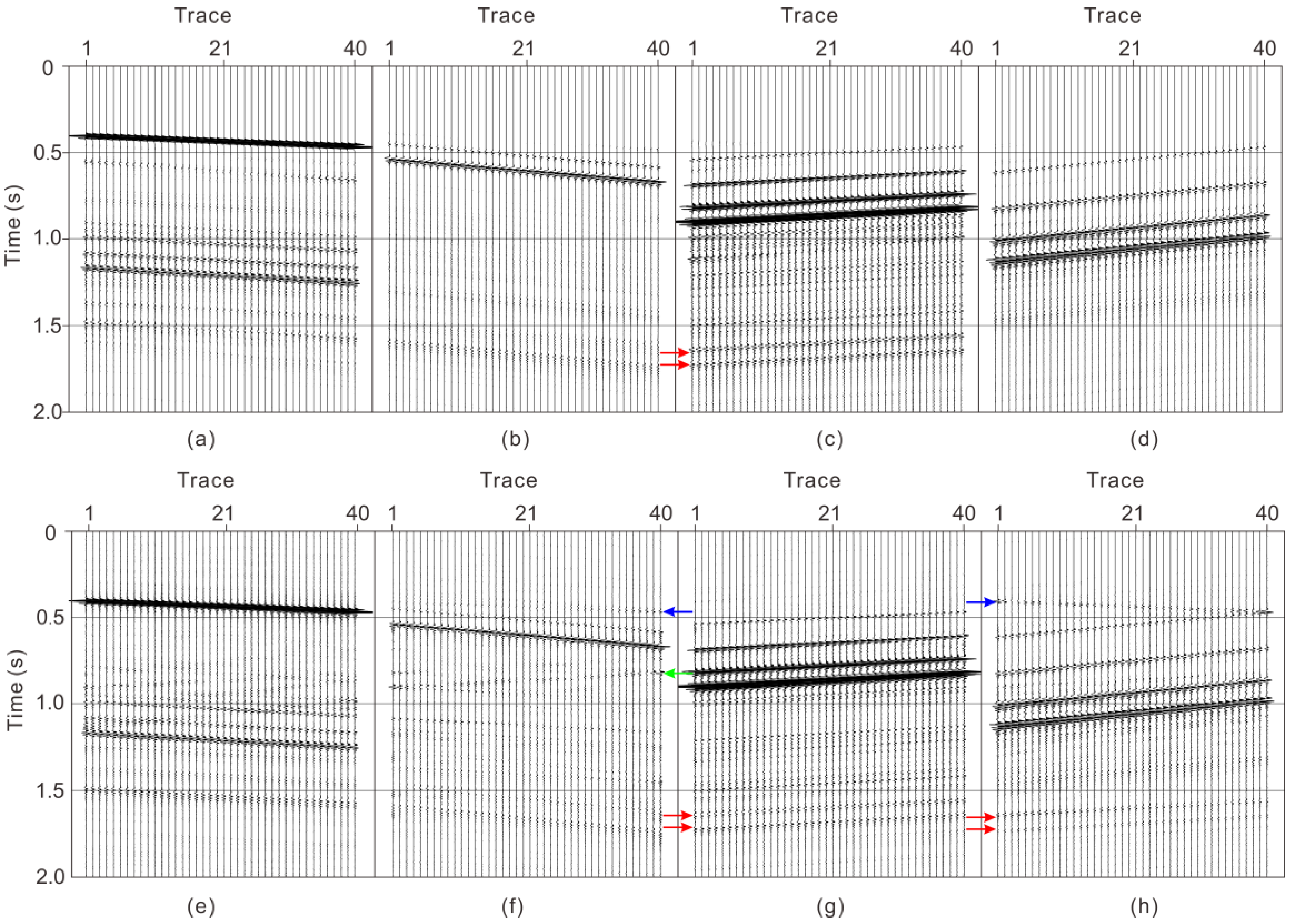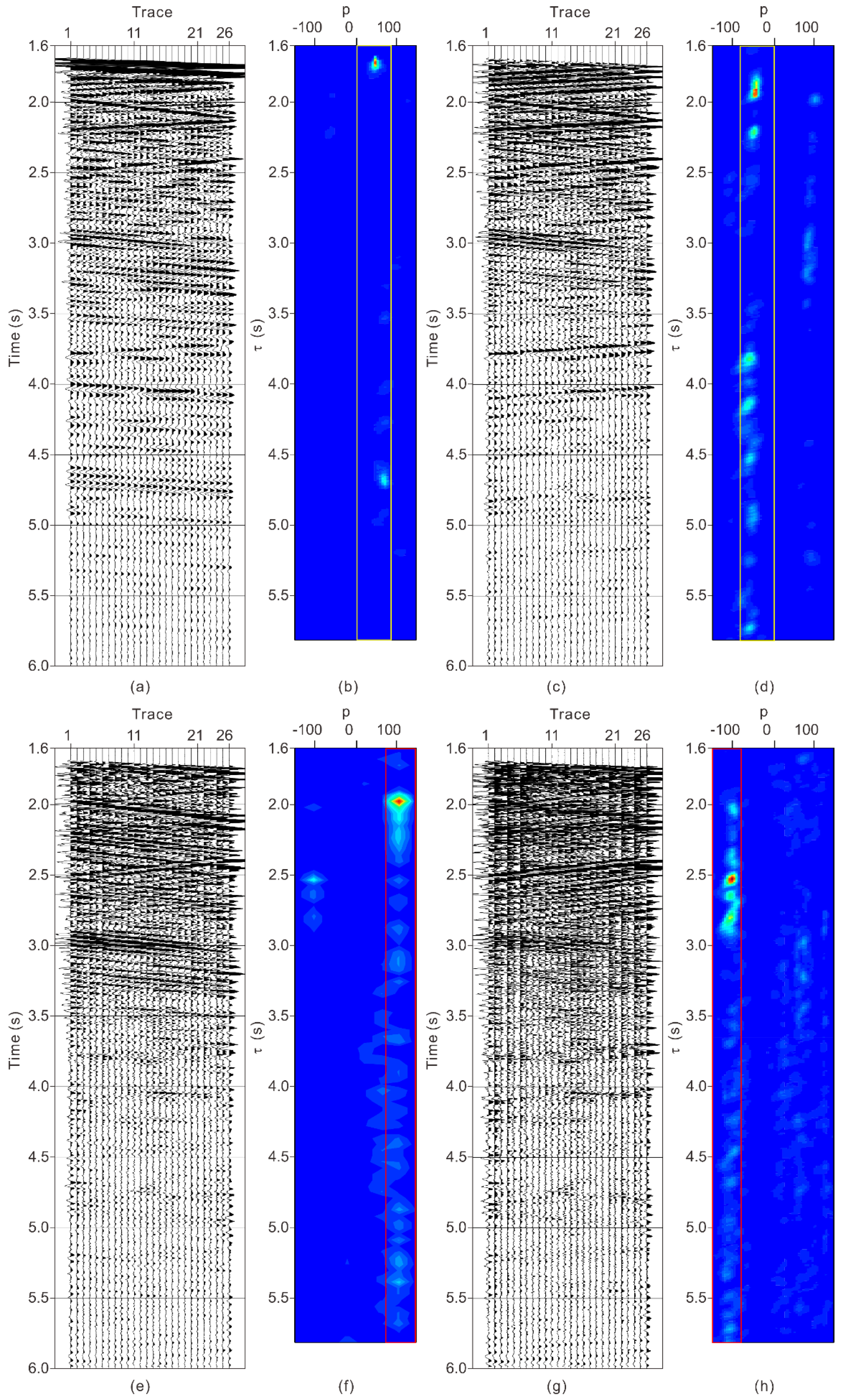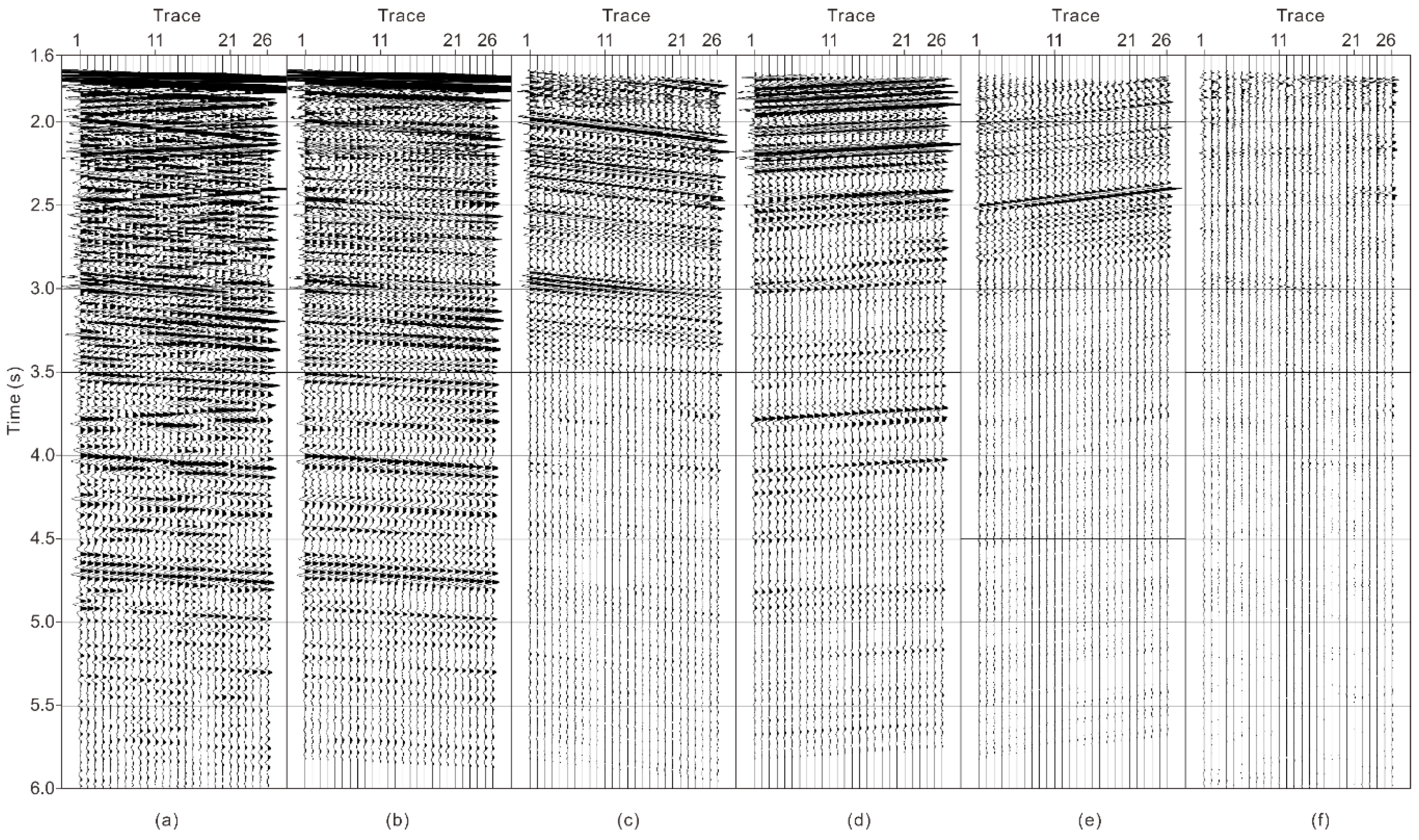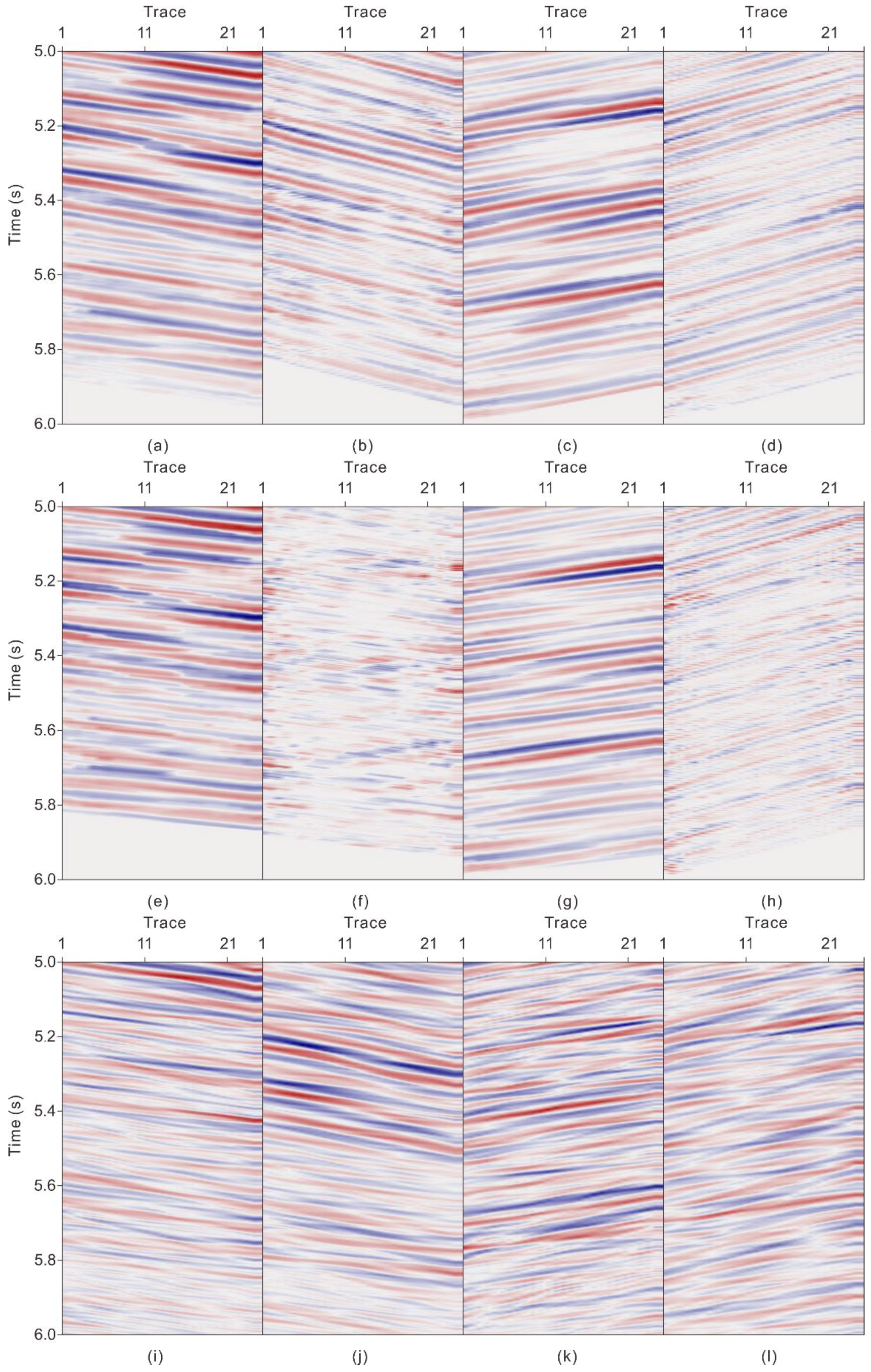1. Introduction
In a vertical seismic profile (VSP) recording, positive-slowness downgoing wavefields and negative-slowness upgoing wavefields interfere with each other [
1]. An effective separation of original VSP data (common shot point gather) is essential before imaging, and separation represents one of the fundamental processing steps for VSP data [
2]. Many methods exist that can be used successfully to separate wavefields propagating uniformly within a chosen analysis window [
3,
4,
5,
6].
The f–k (frequency–wave number) filtering method utilizes the difference of the slowness in the upgoing and downgoing waves for wavefield separation [
7]. However, the overlap of the energy spectrum between different f–k quadrants can prevent these wavefields from being separated accurately [
8]. Additionally, spatial samples are required to be sufficiently dense, otherwise the spatial alias frequency is generated. Glangeaud et al. [
9] pointed out that for an f–k filter, a stable wavefield separation depends on the discrimination of different wavefields in the f–k domain. The Radon transform is a method of wavefield separation in the
τ–
p (intercept time–slowness) domain that utilizes the slowness of the upgoing and downgoing waves [
10], and it can be implemented with either a linear Radon transform (also called the
τ–
p transform [
11]) or a nonlinear Radon transform. Miao et al. [
12] proved, through a case study, that the Radon transform wavefield separation technique is effective for separating the upgoing and downgoing waves, and application of a hyperbolic filter further improved the wavefield separation. Trad et al. [
13] introduced the sparse constraint and proposed the high-resolution Radon transform method, which can be used to improve the accuracy of wavefield separation. Sacchi et al. [
14] used an iterative double weighted conjugate gradient algorithm to solve nonlinear inversion problems of the high-resolution Radon transform. However, the resolution and AVO (amplitude versus offset) characteristics of common Radon transform methods are hard to retain [
15].
The methods for wavefield separation with amplitude preservation include median filtering [
16], mean filtering, and various other improved methods [
17,
18,
19,
20]. Among these methods, median filtering has been widely used for VSP wavefield separation because of the resulting low amplitude change and the stability in cases of short arrays. In order to effectively separate VSP downgoing and upgoing waves, Rao et al. [
21] combined the
τ−
p domain masking filter, the median filter, and the f−k domain masking filter in a dynamic manner. Kommedal et al. [
8] compared the median filter and other methods commonly used in the industry and showed how the median filter treated coherent and random noise; they also demonstrated that the median filter had a unique ability to preserve discontinuities and avoid smearing. Mars et al. [
22] developed a new type of multichannel filter called a “constrained eigenvector filter”; this method can obtain better separation results than the median filters and eigenvector filters because it combines the advantages of the two approaches. In the application of these methods, seismic traces should be aligned according to the first arrival of the target wavefield [
23]. Therefore, extensive first-break pickup work is inevitable and the events of a target wavefield can be aligned only if the first arrival is parallel to the other events of the target wavefield.
However, a different offset of the same wavefield will result in non-parallel events in the non-zero offset VSP [
24,
25]. Furthermore, the events of the same wavefield may come from different reflection layers and the reflection coefficients may be different, which will lead to changes in the slowness and the non-parallel events of the same wavefield. Therefore, a static time shift cannot exactly align the events of the target wavefield, thus resulting in a reduction of the wavefield separation accuracy.
In this paper, we propose a new median filtering method based on the constraint of the linear Radon transform to separate four kinds of wavefields whether or not the events in the wavefields are parallel. We first use a new superposition algorithm of the linear Radon transform to make the energy spectrum in the τ–p domain more focused than the traditional Radon transform so as to obtain the exact slowness value and variation of the slowness at different intercept times. Secondly, all the upgoing and downgoing P-waves and S-waves are aligned dynamically based on the variation characteristics of the wavefield slowness instead of just aligning the first arrivals in a routine VSP process. Lastly, we employ median filtering to separate four wavefields gradually according to the order of the energy spectrum from strong to weak.
3. Synthetic Data Test
We used synthetic VSP records of a horizontal layered model to test the separation effect of this new method. The parameters of model are listed in
Table 1. The separation results were compared with the theoretical results and the results of the high-resolution Radon transform [
13,
30]. We set the wavelet as a Ricker wavelet with the peak frequency of 30 Hz, the initial phase was 0 degrees and it acts as an omni-directional point source. As shown in
Figure 4, the geophones were located at the depth of 700–900 m with the interval of 5 m. The reflection coefficients were calculated through solving the Zoeppritz equations [
31] at all the ray-paths derived using the ray-tracing method proposed by Levoy [
32]. Then, we synthesized the VSP record (
Figure 5) through the convolution of the wavelet and calculated reflection coefficients.
Figure 5 shows that the upgoing and downgoing P-waves and S-waves are mixed together. Because of the short array (the array length of the geophones was 200 m, which was 10% of the last layer depth), the events were approximately a straight line.
In order to compare the degree of energy spectrum focusing based on the conventional Radon transform and the modified Radon transform, we used Equations (5) and (7) to calculate the results of the two kinds of Radon transform, as shown in
Figure 6.
Figure 6a presents the results of the traditional linear Radon transform, and the local maximum and minimum points are given; notably, the energy spectrum was dispersive and similar to a “bow-tie” shape.
Figure 6b shows the results of the modified Radon transform, and some local maximum points were in a vertical arrangement. Through a comparison of
Figure 6a,b, we found that the energy spectrum of the modified Radon transform was more focused in the slowness direction, and the resolution was obviously improved, which allowed us to obtain a more accurate slowness.
The transform results in
Figure 6b show that there were obvious differences in the slowness of the P-wave and S-wave events, and the energy spectra were distributed in different slowness regions. The yellow box in
Figure 6b shows the region of the downgoing P-wave energy spectrum. By the linear fitting of the extremum points of this region, we can get
,
. According to Equations (11) and (12), the downgoing P-wave can be obtained by aligning and median filtering, as shown in
Figure 7a. Similarly, by the linear fitting of the extremum points in the region of the S-wave in the red box, we get
,
. The downgoing S-wave can be obtained through Equation (10), as shown in
Figure 7d. The downgoing P-wave and S-wave had only one event, which led to
after linear fitting of the slowness, which means that the dynamic time shift became static. At the same time, the high-resolution Radon transform was used to separate the downgoing P-wave and S-wave from the original VSP data, as shown in
Figure 7b,e. To verify the separation results, we synthesized the downgoing P-wave and S-wave, as shown in
Figure 7c,f. The travel time, phase, and amplitude of the downgoing P-wave and S-wave were consistent with the theoretical results as determined through the comparison of the theoretical results with those from our method and the high-resolution Radon transform method.
After separating the downgoing P-wave and S-wave, we used Equation (5) to perform the linear Radon transform for the remaining wavefield, and we used Equation (7) to carry out the modified Radon transform. The results are shown in
Figure 8. Similar to
Figure 6,
Figure 8 shows the energy spectrum divergence in a bow-tie shape, and the energy spectrum of the modified Radon transform was more focused in the slowness direction; the resolution was obviously improved, and so a more accurate slowness could be obtained. Based on Equation (5), the spectral values in
Figure 8a are the superposition values of amplitudes along a straight line. However, based on Equation (7), they are the ratios of the superposition amplitudes to the variance of the amplitudes along a stack path. When the amplitudes along a certain stack path are similar, the variance value is close to zero. Thus, compared with the traditional
τ–
p transform, we can get more discriminative spectral values in
Figure 8b, which are then employed to constrain the median filtering.
In the results of the modified Radon transform (
Figure 8b), the yellow box shows the region of the upgoing P-wave energy spectrum. By the linear fitting of the extremum points of this region, we can get
,
. According to Equations (11) and (12), the upgoing P-wave can be obtained by aligning and median filtering, as shown in
Figure 9a. Similarly, by the linear fitting of the extremum points in the region of the S-wave in the red box, we get
,
. The upgoing S-wave was obtained through Equation (10) and is shown in
Figure 9d.
In order to further test the performance of the proposed method, we adopted a VSP record with more complicated wave interference. The parameters of model 2 are listed in
Table 2. As shown in
Figure 10, the distance between the source and well is 600 m. The geophones are located at the depth of 600–795 m with an interval of 5 m. In the modelling, we applied the staggered-grid finite difference simulation. The peak frequency of Ricker wavelet was set as 50 Hz. As shown in
Figure 11, the synthesized record presents more reflections and multiples, which intersect and interfere with each other.
Our separation results (
Figure 12a–d) were compared with the results of the high-resolution Radon transform (
Figure 12e–h). They are displayed with the same gain parameters. It can be seen in
Figure 12f that in the vicinity of 0.8 s, there are a few mixed upgoing wavefield events marked by the green arrow.
Figure 12f,h contain the weak P-wave first arrivals marked by the blue arrows. As shown in
Figure 11, there are two parallel events over 1.6 s indicated by the red arrows, which are both upgoing P-waves. In our method, they are well separated and shown in
Figure 12c and marked by the red arrows. However, the high-resolution Radon transform method cannot well separate these events as shown by the red arrows shown in
Figure 12g,h.
4. Field Data Application Results and Discussion
In order to test the application effect of this method, we used the original VSP data of the Z component in the Tuoputai area, Tarim Basin. The geophones were located from 3500 m (level 1) to 3750 m (level 26) in the TP327CH well at a spacing of 10 m. The target layer was located at the Middle Ordovician Yijianfang Formation (O2yj) at 6807–7378 m in the well. The reservoir space was mainly composed of fractures and pores with large scales and general connectivity. The reservoir lithology was dominated by pelsparite. The depth of the target layer was deeper than that of the geophones, and so the separation and imaging of the deep wavefield in the seismic records was very important for reservoir predictions.
Figure 13a illustrates one of the common shot point gathers. In the seismic records, the upgoing and downgoing waves were mixed with each other. First, the modified Radon transform was performed using Equation (7), and the results are shown in
Figure 13b. Because the downgoing P-wave energy spectrum was the strongest, the region in the yellow box of
Figure 13b could be preliminarily determined as the P-wave energy spectrum. By linear fitting the position of the extreme point in the region of the longitudinal wave energy spectrum, we get
,
. According to Equations (11) and (12), the downgoing P-wave can be obtained by aligning and median filtering, and the results are shown in
Figure 14b. The residual wavefield is shown in
Figure 13c, and the modified Radon transform results are shown in
Figure 13d. The red box area of
Figure 13d was negative, which was determined as the upgoing P-wave, and after fitting the extreme value points,
,
were obtained. According to Equations (11) and (12), the upgoing P-wave can be obtained, and the results are shown in
Figure 14c. Analogously, the residual wavefields (
Figure 13e,g) and their modified Radon transform results (
Figure 13f,h) were obtained. The upgoing P-wave (
Figure 14d) and the upgoing S-wave (
Figure 14e) were obtained by fitting the slowness points and median filtering.
Figure 14a illustrates original VSP data. Comparing the separation results (
Figure 14b,e) with the original data (
Figure 14a), it is clear that there is not any wavefield interference in the separated upgoing and downgoing P-waves and S-waves from the proposed method. From
Figure 14f, we can see that the residuals from the wavefield separation are mainly noise.
In the process of wavefield separation, the upgoing and downgoing waves can be easily distinguished by the positive and negative slowness. The key is in how to distinguish the P-wave and S-wave. Equation (1) shows that the slowness is determined by the direction and velocity of wave propagation. The S-wave has a smaller projection angle, reflection angle, and velocity than the P-wave, which makes the absolute slowness value of the S-wave greater than that of the P-wave. For the same type of wavefield, the angle φ may be changed, and so it should not be ignored for the accuracy of the separation results. However, the variation of cosφ is much smaller than the velocity difference between the P-wave and S-wave. Therefore, the energy spectra of the P-wave and S-wave on the slowness spectra can be separated.
For comparing
Figure 14a,c, the downgoing P-wave including the first arrival of the P-wave was subtracted. The energy spectrum positions in the yellow box in
Figure 14b correspond to the events of the downgoing P-wave in
Figure 14a. By comparing
Figure 14b,d, one can see that the upgoing P-wave energy spectrum of the remaining wavefield appeared after subtraction of the downgoing P-wave. After separating the upgoing P-wave from
Figure 14c, the residual wavefield was obtained as shown in
Figure 14e. The comparison between
Figure 14d,f shows that when all the P-wave data were subtracted, the energy spectrum of the downgoing S-wave appeared, as shown in the red box of
Figure 14f. Then, the downgoing S-wave was subtracted from
Figure 14e and the energy spectrum of the upgoing S-wave appeared (
Figure 14h). In the above process, the wavefields were subtracted in the order of the energy spectrum from strong to weak (downgoing P-wave, upgoing P-wave, downgoing S-wave, upgoing S-wave). With this process, after the former wavefield is subtracted, the energy spectrum of the later wavefield appears.
In order to verify the accuracy of the results, the methods of high-resolution Radon transform and static time shifting (traditional median filtering) were used to separate the original data. We compared the separation results for our method with the high-resolution Radon transform method and static time-shift separation results at 5000–6000 ms, as shown in
Figure 15. The contrast indicated that parts of the events of the deep reflection wave were broken by the static time-shift median filtering method, which was obviously due to the inaccuracy of the slowness value that resulted in the misalignment of events. However, the median filtering method based on dynamic alignment, because the event is aligned according to the actual accurate slowness value, basically did not reproduce the event faults. The results of the high-resolution Radon transform showed better continuity for some local events, but this method destroyed the variation of the amplitude and presented characteristic bifurcation patterns.
As shown in
Figure 16, we compared the residuals of the three methods to analyze whether there is important energy left. In the red and green quadrilaterals, there are several obvious downgoing wave events in
Figure 16d but not in
Figure 16b,c. In addition, the blue quadrilaterals in
Figure 16c show a weak downgoing wave event but there are no events left in the corresponding position in
Figure 16b. Besides, the slowness spectrum of residual wavefield using our method is the weakest of
Figure 16i–k. This indicates that the effective energy left in residual wavefield using our method is less than those of other methods.
In the slowness spectrum, the upgoing and downgoing waves can be distinguished according to the positive or negative characteristics of the slowness with the proposed method. The P-waves and S-waves can be distinguished by the magnitude of the absolute value of the slowness because of the differences in the velocity and incidence angle. According to the results of this study, although the slowness of the same wavefield was variable with the intercept time, the quantity of the variation was not enough to exceed the slowness difference between the P-wave and S-wave, and so in the slowness spectrum, the P-wave and S-wave could be distinguished. Because of the differences in the energy spectrum between different wavefields, the four wavefields were separated successfully according to the priority ranking based on the order of the energy spectrum from strong to weak.
Our method is suitable for VSP data with short arrays, and it is based on the assumption of straight events and linear variation of slowness. For long arrays or complex strata, data could be decomposed into several short array datasets, which is an approach that will be assessed in future research. Because we separate the wavefields in common-shot gather using our method, it is applicable for 2D and 3D offset-VSP data. In regard to the results derived with this method, there were some errors encountered in approaching the first and the last trace. In general, less geophones for VSP data will result in larger ratios of the error trace, which is caused by the systematic error of median filtering. The median filtering can be replaced by mean filtering and singular value decomposition (SVD), and the application effect will be realized in future research.
